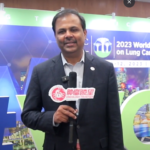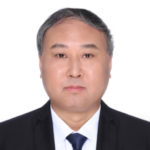The 2023 World Conference on Lung Cancer (WCLC) was held at the Singapore Expo. On the first day, Dr. Chen Haiquan, Director of the Lung Cancer Research Center at Fudan University and Chief of Thoracic Surgery at Fudan University Affiliated Tumor Hospital, gave an important presentation. During an interview with “Oncology Frontier”, Dr. Chen Haiquan shared the key points of his presentation.

Oncology Frontier : Due to the impact of the covid-19 pandemic, it has been several years since domestic experts have engaged in face-to-face exchanges with international scholars at WCLC. Could you share your thoughts and feelings on attending this conference?
Dr. Chen Haiquan:
There are numerous international conferences held every year, and work keeps us busy, so I can only choose to attend the most significant ones. Although I have been a member of IASLC since 2011, this is my first time attending in person. After the covid-19 pandemic, I saw a large number of participants at WCLC, including scholars not only from mainland China, but also from Hong Kong and Taiwan. I also reunited with old friends I hadn’t seen in many years.
Oncology Frontier : You introduced the Asian perspective on lung cancer screening on the first day of the 2023 WCLC. Could you share some highlights from your presentation?
Dr. Chen Haiquan:
This year, I was invited to give two presentations at the WCLC conference, one of which focused on lung cancer screening. During the IASLC CT Screening Symposium held on the first day of the conference (WS04: 2023 IASLC CT Screening Symposium), I presented the Asian perspective on lung cancer screening (WS04.02: Lung Cancer Screening – Asian Perspective). This was the keynote presentation for this session, where we engaged in discussions and debates. This is the third time I have represented Asia in speaking at international conferences. I also presented on behalf of Asia at the 2019 European Association for Cardio-Thoracic Surgery (EACTS) Annual Meeting and the 2021 Society of Thoracic Surgeons (STS) Annual Meeting. Despite being an international lung cancer conference, scholars from Europe and the United States still dominate the presentations. We need to work harder to conduct better research and gain more influence.
Every year, new studies emerges that change clinical practice. Therefore, the content of presentations varies from year to year. At WCLC, we also had new research data from scholars in Taiwan and Chinese-Canadian scholars supporting our findings. In my presentation, I emphasized that Asian patients with lung cancer should be divided into two categories: smokers and non-smokers. Non-smoking lung cancer, female lung cancer, and young lung cancer are more common in Asia, and many are ground-glass nodule-type lung cancers, which differ from the screening results in Western populations. How should we screen for this type of lung cancer? What should be done after it’s diagnosed? How should surgery and post-operative follow-up be conducted?
In terms of lung cancer screening, I proposed a “low-age, low-frequency” screening strategy to minimize the burden on patients. The management approach differs from traditional lung cancer. We conducted a series of studies that demonstrated that preoperative examinations for these patients can be very simple, without the need for complex tests as in the past.
Regarding surgical methods, our team advocates selective lymph node dissection instead of systematic lymph node dissection or sampling for all lung cancer patients. We propose the concept of “selective lymph node dissection” where the approach varies based on the patient’s condition, including no lymph node dissection, selective dissection, or systematic lymph node dissection. Based on clinical data, we first published an article on sublobar resection under frozen pathology guidance in the Journal of Clinical Oncology (JCO) in 2016. Building on this, we introduced the concept of “Comprehensive Minimally Invasive Treatment 3.0” for lung cancer and added the new concept of the “Cure Window Period” this year.
Post-operative follow-up strategies are also different from the past. In the past, we recommended semi-annual follow-ups within three years after lung adenocarcinoma surgery, and then annual follow-ups if there was no recurrence after three years. In our research, we found that for these patients, if the postoperative CT scan results are good, they can go without follow-ups for 2-3 years. The key is to avoid overdiagnosis and overtreatment.
We conduct research and publish articles, and the importance of these articles may not be immediately apparent. However, over time, the value of these research findings can be proven. For example, our first article on gene mutation analysis in East Asian non-smoking lung adenocarcinoma patients, published in the JCO journal in 2010, showed a high rate of EGFR mutations, changing the way we understand the disease. In 2012, an article found that the RET fusion gene could define an independent molecular subtype. We introduced the concept of Comprehensive Minimally Invasive Treatment 3.0 and the Cure Window Period. These findings are groundbreaking and have fundamentally changed our understanding of the disease, altering our clinical practice and allowing patients to live longer and better lives.
Oncology Frontier : What are the significant challenges in the diagnosis and treatment of thoracic tumors in the future?
Dr. Chen Haiquan:
Our surgeons are primarily responsible for early-stage lung cancer patients. Some resectable early-stage lung cancer patients require perioperative treatment. There are three treatment approaches: neoadjuvant treatment, adjuvant treatment, or neoadjuvant combined with adjuvant treatment. In Particular, as the effectiveness of immunotherapy has been demonstrated in late-stage lung cancer treatment, the use of immunotherapy in the perioperative period for early-stage non-small cell lung cancer has become a focus of research. Some studies have shown that neoadjuvant or adjuvant immunotherapy can increase the proportion of patients achieving pCR and MPR, improving DFS data. Whether it can improve the 5-year survival of patients is still unknown. We are most concerned about long-term survival and hope to see evidence of long-term survival benefits.


